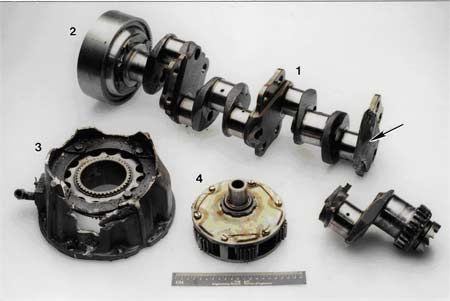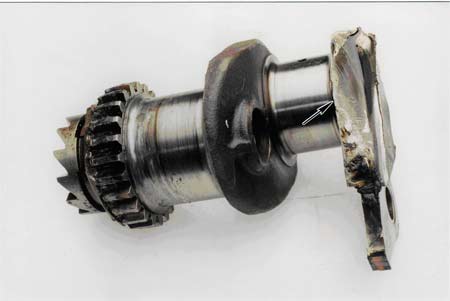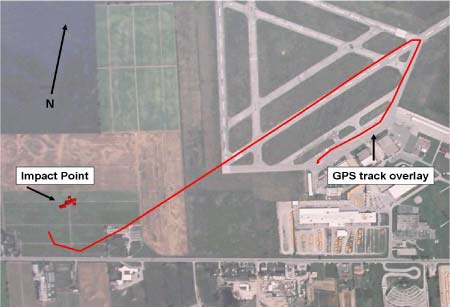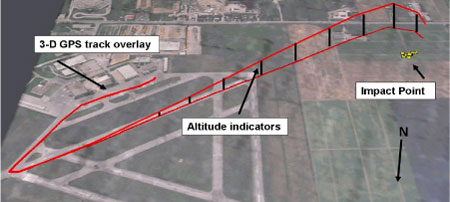Loss of Control-Collision with Terrain
Ryan Aeronautical Navion B C-FTRM
Brantford, Ontario
The Transportation Safety Board of Canada (TSB) investigated this occurrence for the purpose of advancing transportation safety. It is not the function of the Board to assign fault or determine civil or criminal liability. This report is not created for use in the context of legal, disciplinary or other proceedings. See Ownership and use of content. Masculine pronouns and position titles may be used to signify all genders to comply with the Canadian Transportation Accident Investigation and Safety Board Act (S.C. 1989, c. 3).
Summary
The pilot of the privately owned Ryan Aeronautical Navion B aircraft (registration C-FTRM, serial number NAV-4-2340B) departed Burlington, Ontario, under visual meteorological conditions, for a breakfast fly-in at Brantford, Ontario. An en route stop was made in Guelph, Ontario, to pick up a passenger. At approximately 1230 eastern standard time, the pilot and passenger boarded the aircraft and taxied for a departure from Brantford. The aircraft departed Runway 23 at the intersection of Taxiway Bravo and climbed on the runway heading. During the climb, the engine failed, and the aircraft stalled and entered a spin. A single mayday call was heard on the Brantford Unicom frequency. The aircraft struck the ground in a nose down attitude, with the right wing striking first. The aircraft cartwheeled and came to rest 94 feet from the initial impact point. The occupants were fatally injured. There was no post-impact fire.
Factual information
Aviation routine weather reports (METARs) are not available for Brantford. The nearest reporting station is in Hamilton, 18 nautical miles east of Brantford. The Hamilton weather at 1200 eastern standard timeFootnote 1 was reported as follows: winds 240° True (T) at 11 knots, visibility 15 statute miles, sky clear, temperature 9°C. Similar conditions were present at Brantford. Weather was not a factor in the accident.
The occurrence Navion, manufactured in 1951, was a four-seat, low-wing aircraft with retractable landing gear and a clear, bubble-shaped canopy. It was equipped with a two-bladed, hydraulically operated, controllable-pitch propeller (Hartzell HC-12V20-8C) connected to the engine via a reduction gearbox. According to the journey log, the aircraft was not flown between 05 October 1984 and 03 June 2002 because it was being refurbished. The occurrence pilot purchased the aircraft on 20 December 2003.
The aircraft was equipped with a certified emergency locater transmitter (ELT), which did not activate during the occurrence. The three-position (ON, OFF, and ARM) ELT switch was found in the OFF position at the occurrence site. When the switch was turned to the ON position, the ELT operated normally. Due to the location of the accident, the lack of an ELT signal did not affect search and rescue operations.
In June 2004, the aircraft was involved in a propeller ground strike incident in which the propeller blades were substantially damaged. The propeller assembly was removed and sent to an overhaul facility for repair. The propeller ground strike incident was not recorded as an abnormal occurrence in either the aircraft journey log or the technical logs. Also, there was no record of the propeller removal or who may have removed it. There was no record that the reduction gearbox was removed to inspect the crankshaft for eccentricity or that the aircraft was inspected to determine its airworthiness. This is not in accordance with Section 605.88 of the Canadian Aviation Regulations (CARs), which states the following:
605.88(1) No person shall conduct a take-off in an aircraft that has been subjected to any abnormal occurrence unless the aircraft has been inspected for damage in accordance with Appendix G of the Aircraft Equipment and Maintenance Standards.Footnote 2
The overhaul of the propeller was completed on 29 September 2004. Entries in the aircraft journey log indicate that it was installed on the occurrence aircraft on 29 November 2004. The journey log also indicates that the aircraft was flown five times before 29 November 2004 without a certified maintenance release. The installation was completed by someone other than the individual who signed the logbook entry. It could not be determined who had completed the installation. Conducting a flight in an aircraft that does not have a certified maintenance release is not in accordance with Section 605.85 of the CARs, which states the following:
605.85 (1) Subject to subsections (2) and (3), no person shall conduct a take-off in an aircraft, or permit a take-off to be conducted in an aircraft that is in the legal custody and control of the person, where that aircraft has undergone maintenance, unless the maintenance has been certified by the signing of a maintenance release pursuant to section 571.10.
Since 1978, there have been 35 documented occurrences related to the fuel selector valve on various models of the Navion. The valve has a history of internal leakage, which causes air ingestion. On 23 August 2005, Navion issued Service Bulletin 101A, regarding the replacement of the existing fuel selector valve.
As part of the TSB investigation, the fuel selector from the accident aircraft was removed from the wreckage and sent to the manufacturer for testing. On initial inspection, the valve showed evidence of previous repair; however, there are no known approved repair procedures. The valve was configured with three inlet ports: one for the main tank and one for each tip tank. The valve was tested, and it was discovered to have internal leakage from the right tip tank port to the main fuel port. Although the fuel selector valve failed during testing, it was determined that it did not contribute to the engine failure.
Transport Canada provides guidance to aircraft owners and operators regarding compliance with voluntary service bulletins in Airworthiness Notice B055, Edition 1-4. The purpose of this notice is to clarify the need to comply with manufacturers' service bulletins. In part, this notice states the following:
Except where otherwise specified in Std 625, Appendix C, compliance with publications dealing with these topics is optional. However, aircraft owners have a duty to be aware of the contents of these publications, and to evaluate the need for compliance in light of their own circumstances. Commercial operators should have a formalized process for conducting this evaluation, as part of the evaluation program required by CAR 706.
There was no indication of compliance with Navion Service Bulletin 101A on the occurrence aircraft, and there is no reasonable way in which it could be interpreted as requiring mandatory compliance under the CARs.
The Lycoming GO-435-C2 engine was manufactured in 1950 and installed in C-FTRM in 1955. It had accumulated approximately 2690 hours since installation and had undergone three subsequent overhauls, the last in 1997. Approximately 101 hours had been accumulated on the engine since the last overhaul.
When the aircraft struck the ground, the engine sustained substantial damage due to impact forces. The propeller shaft was sheared off forward of the reduction gearbox. The propeller spinner was severely crushed and hydro-formed over the propeller hub, indicating a steep impact angle. The damage to the propeller blades was consistent with an engine producing little or no power at impact. The engine was torn from its mounts and was attached to the airframe by only various wires and hoses.
The engine was disassembled in the TSB regional wreckage examination facility. During disassembly, it was discovered that the crankshaft had fractured, resulting in substantial rotational damage to the interior of the crankcase. Examination of the crankshaft fracture surface revealed signs of fatigue failure. There was no reference to any abnormalities or deficiencies to the crankshaft during any of the overhauls.
Parts of the crankshaft, together with the disassembled components of the engine-to-propeller reduction gearbox, were sent to the TSB Engineering Laboratory to determine the cause of failure. Because the aircraft suffered a propeller strike in June 2004 (70 hours before the accident), all components of the gearbox were disassembled, ultrasonically cleaned, and examined with a binocular microscope. No indication of sudden stoppage, in the form of cracked or broken gear teeth, or unusual gear tooth surface markings, was found.
The fractured crankshaft and parts of the engine-to-propeller reduction gearbox assembly are shown in Photo 1. The location of the failure, as shown in Photo 1 by the small arrow, was at the forward fillet radius of the number six connecting rod journal (see Photo 2 - Close-up of fractured crankshaft). The location of the failure, as shown in Photo 1 by the small arrow, was at the forward fillet radius of the number six connecting rod journal (see Photo 2 - Close-up of fractured crankshaft).
A crack on the crankshaft initiated on the surface of the forward fillet radius to the number six connecting rod journal. Examination of the crankshaft revealed crack progression markings that confirmed the fracture as a progressive fatigue failure. The fatigue crack progressed across 95 per cent of the cross section of the crankshaft, before its fracture. The final fracture occurred as the weakened shaft was unable to sustain the applied loads. The transition from the fatigue crack to the fracture appeared continuous, indicating that the failure occurred while the engine was being run under normal operations.
A section of the fracture surface, including the crack origin area and a portion of the fillet radius, was removed for scanning electron microscope (SEM) examination. This examination did not reveal any overload, such as a propeller strike, before or after the initiation of the fatigue crack. Close inspection of the origin area with the SEM showed regions of corrosion pitting, which may have been where the fatigue crack originated.
The material of the crankshaft was a low alloy steel containing manganese, chromium and nickel alloying additions. The general structure of the crankshaft showed hardness consistent with the required quenched and tempered heat treatment process, performed during the manufacture of the crankshaft. However, the forward fillet radius to the number six connecting rod journal and the journal surface showed an absence of case hardening at the origin of the fatigue crack. The equivalent location on the aft fillet radius and the forward radius 180° from the fatigue crack origin showed acceptable case hardened layers. The number five connecting rod journal also showed the presence of normal case hardened surface layers. There is no indication in the engine logbooks of any reworking of the crankshaft. It is possible that the absence of the case hardening at the fatigue crack origin dates from the time of manufacture and installation in the engine. This may have contributed to a faster crack growth rate than would normally be the case for a properly manufactured crankshaft.
The aircraft was equipped with a Garmin 295 global positioning system (GPS). Although extensively damaged during the accident, the GPS memory was successfully downloaded at the TSB Engineering Laboratory. Information regarding the occurrence take off was retrieved from the GPS (see Appendix B - GPS Overlay of Brantford Airport). The data indicated that the aircraft climbed at a rate of 850 feet per minute (fpm) until reaching an altitude of 450 feet above ground level (agl). The groundspeed decreased from 72 mph to 48 mph and the track of the aircraft increased from 222° T to 273° T before any loss of altitude. The rate of descent was initially 1300 fpm and increased to 3000 fpm before impact.
According to the Navion operating manual, the stall speed with the gear and flaps retracted is 71 mph indicated airspeed (IAS) for the approximate weight of the occurrence aircraft at take-off. The stall characteristics of the Navion are described as smooth; the aircraft will pitch straight forward with no tendency to roll or yaw. With the gear and flaps retracted in a power-off stall, a slight tail buffet is noticed preceding the break. This aircraft was not equipped or manufactured with a stall warning device. The emergency procedures for an engine failure during take-off, which are pertinent to this occurrence, are outlined in the Navion operating manual as follows:
- Depress the nose so the airspeed does not fall below landing speed. Keep the indicated airspeed well above stalling speed.
- Land straight ahead, changing directions only enough to avoid obstructions.
The pilot obtained a private pilot licence in January 1974. He had accumulated approximately 880 hours of total flight time, including 105 hours on the Navion. He flew regularly and was current on the aircraft. To meet recency requirements, the pilot attended Transport Canada safety seminars in February 2003 and October 2004. The seminars covered pilot decision making and pilot and aircraft documents respectively. According to Section 401.05 of the CARs, if a pilot has flown as pilot-in-command at least once in the previous five years and has completed an acceptable recurrent training program within the past 24 months, such as the Transport Canada safety seminars, the recency requirements have been met. There was no record of any further training or check rides subsequent to his initial training for his private pilot licence, nor was any required. He was certified and qualified for the flight in accordance with existing regulations.
To fly as pilot-in-command in the United States, a pilot must have had a flight review within the last 24 months. This flight review consists of a minimum of one hour of flight training and one hour of ground training, and it includes a review of the manoeuvres and procedures that are necessary for the pilot to safely exercise the privileges of the pilot certificate.
Without regular reinforcement, skills degrade over time following learning. The amount of degradation is related to the level of proficiency achieved at the completion of learning, the length of time since the skills were learned, and the degree to which the skills are rehearsed following the training.Footnote 3 In essence, skills can be most effectively maintained when they are well mastered during training, refreshed during regular retraining, and rehearsed regularly between retraining sessions.
This cycle of retraining is most critical for procedural tasks with a number of discrete steps (for example, response to an engine failure), since these types of tasks have been shown to degrade the most over time. Conversely, continuous tasks, which are more automatic and for which cues are provided by the environment, show minimal degradation over time (for example, manually flying an aircraft on a visual approach).
Analysis
As indicated in the factual section of the report, the faulty fuel selector valve did not contribute to the engine failure. There was no indication of sudden stoppage in the engine-to-propeller reduction gearbox; therefore, the prior propeller strike was not a factor in the failure of the crankshaft. The analysis will focus on the factors directly related to the occurrence: the fatigue failure of the crankshaft, and the ensuing stall and spin that followed the power loss.
The crankshaft failed as a result of a fatigue crack that developed on the forward fillet radius of the number six connecting rod journal. The crack most likely originated in an area where there was corrosion pitting. The fatigue crack developed at an undetermined time during the lifecycle of the engine and was not discovered on any of the three overhauls that were recorded in the aircraft logbooks. The crack appeared to have spread under normal operating conditions until the crankshaft could not support the required operating loads. The absence of a case-hardened layer on the fillet radius in the region of the fatigue crack initiation also contributed to the failure. The deficiency in the material heat treatment condition is believed to have been the result of a manufacturing error. Fatigue failure of the engine crankshaft resulted in a complete loss of power.
Maintaining proficiency and adequate flying skills can be a challenge, particularly for general aviation pilots who fly relatively infrequently. The pilot was current, and had adequate experience; therefore, it could be expected that he would have had no problem flying the aircraft during normal operations. However, depending on training, experience and personal characteristics, a pilot may become incapable of performing the required procedures during an emergency. The more training a pilot has on emergency procedures, the better the performance. A paramount distraction, such as an engine failure, can cause the pilot to focus on the immediate emergency instead of on flying the aircraft.
There is no indication that the pilot's flying abilities had been assessed by a qualified person since his initial licensing in 1974. Although this pilot's flying activity exceeded the minimum requirements of Subsection 401.05(1) of the CARs, it is unlikely that critical flight skills and procedures were practised to ensure proficiency. The current recency requirements in Canada allow pilots to go for extended periods without any retraining in critical flight skills, creating the risk that pilots will not be prepared to deal with unusual or critical flight situations when they arise.
It could not be ascertained whether the pilot made an attempt to return to the airport for landing, or if he was sufficiently distracted with the engine failure to lose control of the aircraft. Regardless, he did not follow the emergency procedures for engine failure after take-off, and as a result, the airspeed decreased below a safe flying speed, and the aircraft stalled and entered a spin from which there was insufficient altitude to recover.
The following Engineering Laboratory reports were completed:
- LP 139/2005-Crankshaft Failure Analysis
- LP 131/2005-GPS Analysis
These reports are available upon request from the Transportation Safety Board of Canada.
Findings
Findings as to causes and contributing factors
- A fatigue crack developed in the engine crankshaft as a result of corrosion pitting and the absence of a case-hardened layer on the fillet radius of the number six connecting rod journal. The fatigue failure of this section of the engine crankshaft resulted in a complete loss of power.
- Control of the aircraft was not maintained during the power loss event, and consequently the airspeed decreased below a safe flying speed. The aircraft stalled and entered a spin from which there was insufficient altitude to recover.
Findings as to risk
- The propeller ground strike incident was not recorded in either the aircraft journey log or the technical logs, and there is no indication that the aircraft was inspected afterwards to determine its airworthiness.
- After the overhauled propeller was installed, the aircraft was flown five times before receiving a certified maintenance release. Until such a release is obtained, there is an increased risk that the aircraft may not be airworthy.
- Transport Canada recency requirements allow pilots to fly for extended periods of time without retraining in critical flight skills. The gradual erosion of these skills reduces a pilot's preparedness to react appropriately during emergency situations.
- The fuel selector valve revealed internal leakage during testing. Although not a factor in this occurrence, continued use of a component for which the manufacturer has recommended replacement poses a risk to the safe operation of the aircraft.
Safety Concern
Currently, the recency requirements in Canada allow pilots engaged in recreational flying to continue to exercise the privileges of a licence without having to regularly demonstrate proficiency to another qualified person. Therefore, a pilot may continue flying for years without reinforcing, through practice, those skills considered essential for the initial issuance of a licence (for example, dealing with an engine failure or landing in a crosswind).
In this occurrence, the pilot's flying activity and attendance at the Transport Canada safety seminars exceeded the minimum requirements of sections 401.05 and 421.05 of the CARs. However, it is unlikely that critical flight skills and emergency procedures were practised since his initial licensing in 1974. The absence of pilot recency is also listed as a finding in TSB report A05O0147.
The Board is concerned that there is no requirement for a private pilot to participate in periodic recurrent flight training, such as a biennial flight review. This presents the risk that pilots will not be prepared to deal with unusual or critical flight situations when they arise.
This report concludes the Transportation Safety Board's investigation into this occurrence. Consequently, the Board authorized the release of this report on .
Appendices
Appendix A - Canadian Aviation Regulations
Standard 625 Appendix G
(13) Propeller and Rotor Strikes
Engines and transmission systems which have been shockloaded as a result of the propeller or rotor striking the ground or some object while the engine is running shall be inspected in accordance with the following paragraphs:
- A preliminary inspection shall be made of the blade itself and, if possible, of the object which was struck to aid in estimating the level of shock which can have been transmitted. It is not expected that an accurate assessment be made, but rather that the inspector shall form a general impression of whether the impact was severe or mild. If the level of impact is in doubt, it shall be assumed that a severe shock has been transmitted.
- The need for further investigation will depend upon the results of the preliminary examination, and on the AME's assessment of the probability of further damage, based on the nature of the incident. If further investigation is indicated, the propeller shaft or flange shall be checked for eccentricity (run out check). Limits are those specified by the manufacturer. If the propeller shaft or flange is out of limits, an internal inspection shall be required. In the case of a geared piston engine this shall entail removal of the reduction gear for a check of the crankshaft run out.



